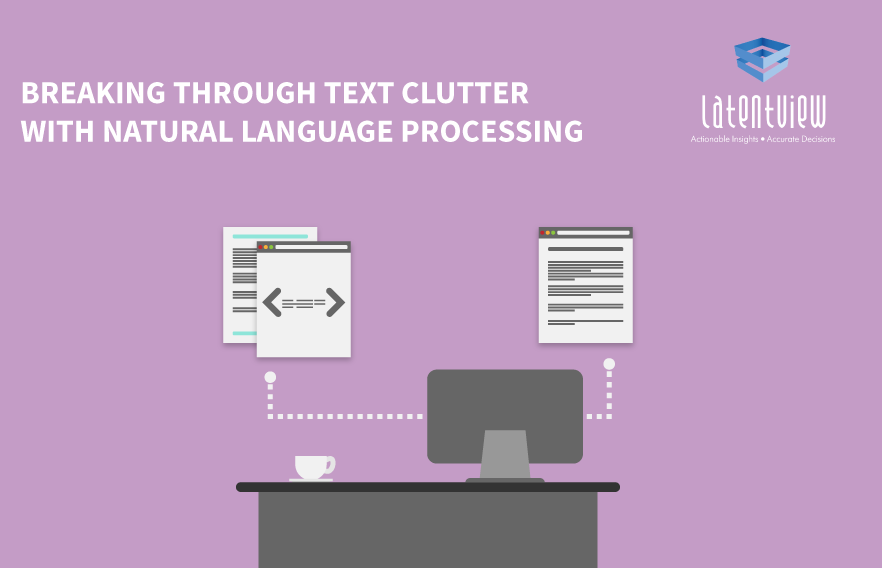Let us face it – There is a data deluge! It is happening right now, accelerating all the time with the world’s data doubling every two years (equivalent of Moore’s law for the data world). A lot of this data is unstructured composed of images, text, speech, videos etc. From a business standpoint, the most fundamental and important piece of unstructured data is “Text” data which is part of business contracts, product documentation, pricing playbooks, marketing media, to name a few. So if organizations can harness these text data assets, which are both internal & external to the enterprise, they can potentially solve interesting and profitable use cases.
Why is Text Analytics Interesting?
Over & above the fact that data in the form of text is available in abundance, it is interesting because it typically packs a lot of information within a short space. For example, look at the snippet of text below, which is a typical email / service request to a customer service center.
As the customer service center is inundated with ream of textual data, it is important to prioritize and understand which piece of information is important to act upon first. With Twitter turning out to be the customer service center, are you equipped to understand the pulse of the consumer in real time?
In a B2B context, businesses are flooded with information rich documents and there is a need to derive patterns and insights spanning a plethora of document types.
Overall text data analytics is needed to accomplish two main objectives.
Objective 1:
A need for models and techniques to extract structure & meaning within each document.
Objective 2:
Given a content corpus, ways to tease out the relationships & concept similarities that exist within it.
This is where Natural Language Processing(NLP) as a branch of Artificial Intelligence steps in. It is feasible through machine learning & analytics to extract interesting patterns in textual data using techniques in NLP.
How does NLP work?
So the question that NLP tries to answer is: “Given a large corpus of text, what steps are to be carried out to generate insights and meaning?”
There are a wide range of techniques associated with NLP and indicated below are some of the most important ones in the map.
Each of the techniques mentioned above have strong statistical & mathematical underpinnings. Platforms like Python & R have got packages that help to implement these techniques in a simple yet sophisticated manner.
An Application of NLP: Conceptual Search
One of the interesting branches of NLP is ‘Conceptual Search’ which is about searching a corpus of text to get insights into the different elements. LatentView’s solution approach to implementing conceptual search is given below and this has been applied in Product Innovation, Operational Risk, Data Forensics and a few more. LatentView has also created a ‘ready to deploy’ solution that can be fine-tuned to work in different domains.
Where can NLP be used?
BRAND SENTIMENT ANALYSIS:
With consumers posting tonnes of posts and comments in public domain, understanding the emotional tone, knowing the trending opinion and having a real time view of the customer’s pulse is a critical element of brand marketing. NLP helps to derive these insights from textual data
RECRUITMENT:
Semantic search of resumes to filter the best fit is far more powerful than keyword match. NLP is at the backbone of such targeted selection and recruitment methods.
MEDIA AND PUBLISHING:
Publishing houses deliver news and content after aggregating from a variety of sources. The process of aggregation is far more accurate to the reader’s needs with NLP based selection.
FINANCIAL MARKETS:
With markets swinging wildly as news filters in, the analyst’s need real time and relevant content to be at their fingertips and NLP and contextual search in particular is a powerful weapon that financial companies are seeking eagerly.
CALL CENTER OPERATIONS:
As seen in the example earlier in the post, with a flood of consumer messages arriving, it is critical to decode what is priority and act upon them. And even more interesting is voice based contact centers. With several hours of conversations recorded, using voice to text, NLP and machine learning you can clearly gain insight into the pulse of the consumer.
Here is an interesting video on call center operations and how NLP is relevant (https://www.youtube.com/watch?time_continue=11&v=Rk6xQjhga2c)
Conclusion:
Natural Language Processing (NLP) is growing in stature and can be applied in a variety of situations that deal with text data. In this time where businesses are flooded with more data, these techniques provide decisive insights which was not practical with manual means. LatentView, as experts in harnessing unconventional sources of data, is working on cutting edge NLP techniques helping global brands understand the pulse of the consumer.










